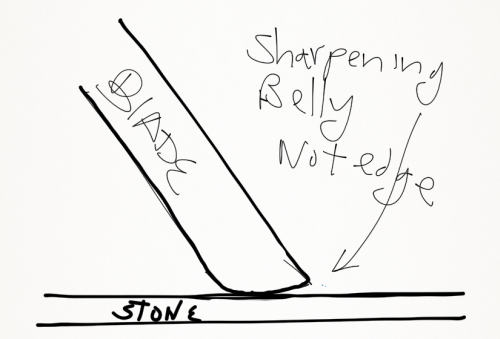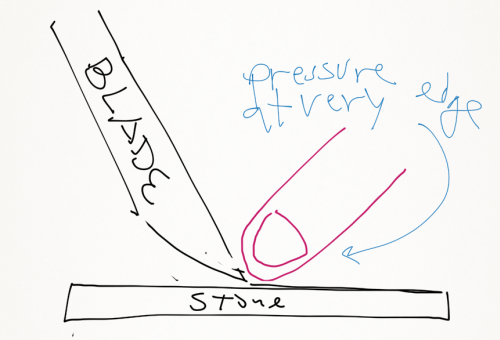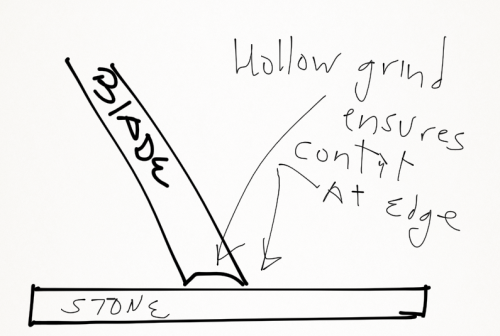 When you sharpen on a stone or sandpaper the hard flat surface of the abrasive gives accuracy over forgiveness. You either are touching the edge of your tool to the abrasive or you are not. Also, as you sharpen it's pretty common to apply pressure at the very edge of the blade and your bevel will slowly acquire a very slight belly. What this means is that the next time you sharpen there is a good chance your solid contact with a stone is actually a solid contact with the tool belly, not the cutting edge. Sometimes slurry gets caught in the gap between bell and edge and you sort of polish the cutting edge, but you don't remove much material and you don't get a burr. When you sharpen on a stone or sandpaper the hard flat surface of the abrasive gives accuracy over forgiveness. You either are touching the edge of your tool to the abrasive or you are not. Also, as you sharpen it's pretty common to apply pressure at the very edge of the blade and your bevel will slowly acquire a very slight belly. What this means is that the next time you sharpen there is a good chance your solid contact with a stone is actually a solid contact with the tool belly, not the cutting edge. Sometimes slurry gets caught in the gap between bell and edge and you sort of polish the cutting edge, but you don't remove much material and you don't get a burr.
This issue applies no matter if you are free handing or using a jig. It's just pretty possible to find yourself spending lots of time sharpening a belly that has no effect on the cutting edge. Most annoying. If you are actually sharpening at the cutting edge, and there is no microbevel or flat to remove first you should be able to turn a wire edge in theoretically one stroke, in practice a couple more. Just polishing the edge means slurry is working but you don't have solid contact at the cutting edge.
There are three simple solutions to this when freehand sharpening (I don't know if there is a solution when using a jig other than shift the tool in the jig). The first is to hollow grind the bevel. The second is always get make sure there is pressure on the very tip of the tool as you sharpen. The third is to lift the tool slightly to ensure contact at the very tip and form a secondary bevel. In the first case, hollow grinding makes it easy to bear on the front edge but you also need a grinder (which I consider an essential shop tool). In the latter cases, over time you will form a belly on the bevel or a series of secondary bevels and each time you sharpen you need to raise the tool a little more. When it becomes hard to continue sharpening or the belly/bevels get so pronounced that the angle of cut gets too high, just go back to square one and hollow grind. Japanese tools are flat ground not hollow ground, but the softer backing material makes developing the belly harder in first place.
 97% of the time when someone complains they can't sharpen and they spent hours on it, it turns out that they were sharpening the belly of the bevel and never came close to the cutting edge. This can be because they have their jig set wrong or they are applying pressure in the wrong place. Some teachers recommend embracing the belly and recommend a stroke that starts at the belly and eventually wipes out at the edge. This works but I think it's a waste of effort. 97% of the time when someone complains they can't sharpen and they spent hours on it, it turns out that they were sharpening the belly of the bevel and never came close to the cutting edge. This can be because they have their jig set wrong or they are applying pressure in the wrong place. Some teachers recommend embracing the belly and recommend a stroke that starts at the belly and eventually wipes out at the edge. This works but I think it's a waste of effort.
 For a lesson in good technique, see my teacher Maurice Fraser explain how to do it consistently. Check out the free website. For a lesson in good technique, see my teacher Maurice Fraser explain how to do it consistently. Check out the free website.
Next time I will talk about how stropping can mitigate some of the rounding belly issues.
|
 Joel's Blog
Joel's Blog Built-It Blog
Built-It Blog Video Roundup
Video Roundup Classes & Events
Classes & Events Work Magazine
Work Magazine


 When you sharpen on a stone or sandpaper the hard flat surface of the abrasive gives accuracy over forgiveness. You either are touching the edge of your tool to the abrasive or you are not. Also, as you sharpen it's pretty common to apply pressure at the very edge of the blade and your bevel will slowly acquire a very slight belly. What this means is that the next time you sharpen there is a good chance your solid contact with a stone is actually a solid contact with the tool belly, not the cutting edge. Sometimes slurry gets caught in the gap between bell and edge and you sort of polish the cutting edge, but you don't remove much material and you don't get a burr.
When you sharpen on a stone or sandpaper the hard flat surface of the abrasive gives accuracy over forgiveness. You either are touching the edge of your tool to the abrasive or you are not. Also, as you sharpen it's pretty common to apply pressure at the very edge of the blade and your bevel will slowly acquire a very slight belly. What this means is that the next time you sharpen there is a good chance your solid contact with a stone is actually a solid contact with the tool belly, not the cutting edge. Sometimes slurry gets caught in the gap between bell and edge and you sort of polish the cutting edge, but you don't remove much material and you don't get a burr.  97% of the time when someone complains they can't sharpen and they spent hours on it, it turns out that they were sharpening the belly of the bevel and never came close to the cutting edge. This can be because they have their jig set wrong or they are applying pressure in the wrong place. Some teachers recommend embracing the belly and recommend a stroke that starts at the belly and eventually wipes out at the edge. This works but I think it's a waste of effort.
97% of the time when someone complains they can't sharpen and they spent hours on it, it turns out that they were sharpening the belly of the bevel and never came close to the cutting edge. This can be because they have their jig set wrong or they are applying pressure in the wrong place. Some teachers recommend embracing the belly and recommend a stroke that starts at the belly and eventually wipes out at the edge. This works but I think it's a waste of effort. For a lesson in good technique, see my teacher Maurice Fraser explain how to do it consistently. Check out the
For a lesson in good technique, see my teacher Maurice Fraser explain how to do it consistently. Check out the
Is it simply incorrect, or a bad idea to hollow grind Japanese Tools?
Robert J
Glad you opened this kettle of fish! No doubt a common problem.
What you didn't stress is the concept of convex bevel honing vs.honing a hollow or flat bevel. In the latter the edge is always in contact with the stone and only maintaining the angle is important. One or two strokes will sharpen the edge. The downside of this is that periodic regrinding is required. However, in the former case of a convex bevel a completely different concept is working. Here the edge is not sharpened but rather "exposed." Metal is removed from the belly of the bevel so as to work toward an edge that thus becomes sharp. Periodic regrinding is not needed. Watch Sellers sharpen. He starts always with a coarse stone and drops his angle as he pushes forward on the stone - affecting the belly of the bevel. So, in summary, convex bevel sharpening requires a completely different mind-set vs. micro bevel or flat bevel or hollow bevel sharpening.
You hone as normal starting at 30º but dip the handle as you go, to round the bevel slightly, but under the angle, not over. You keep going until you can feel a burr across the whole width. If this doesn't come up quickly (i.e. you are sharpening the belly as in your drawing) you move to a coarser stone and remove the belly until it meets the 30º edge. Then back to finer stone as necessary.
Paul Sellers does a good video of this http://www.youtube.com/watch?v=a6ykVzL2VAM and see other comments in his blog.
I hollow grind Japanese chisels but not all the way, ject to get rid of any belly. It's certainly non-traditional but it works and saves me time - so by definition it isn't wrong. If you want to be traditional don't do it.
I do mention starting at the belly method and then wiping out at the edge, which is a three word summary of what Paul Sellers teaches. You lift the tool as you go to insure contact. As I said above, it works, it's easy to teach, easy to learn, nothing wrong with the method. I think maintaining a flat is less work, just requires a slightly longer first lesson and more practice. In either case at some point you end up with a very steep angle which really should be ground. And in Paul's method sharpening paring chisels to a very low angle (15-20 degrees) will quickly result in the bevel angle being higher - which defeats the purpose of the very low angle (although I don't think Paul uses long paring chisels - but I could be wrong).
Needless to say you have a method that works, my point is that a lot of people don't have a method that works, or a method that works inconsistently. The reason is they don't realize that they are polishing a belly not sharpening an edge via one method or another.
I like it personally, because I can FEEL when the cutting edge is starting to abrade. I'd been doing the hollow grind and eclipse guide for 10 years and find the Sellers method faster and WAY more relaxing.
I sharpen pretty much the way you do but my point is that a lot of people have trouble sharpening because they are sharpening a belly without even realizing it. I don't have an axe to grind with any method that actually works.
Paul,
I might have misunderstood Paul's method, I'm certainly not suggesting that it is ineffective, I don't think not having to ever go to a grinder is a good or bad thing. I hollow grind because it's faster, the end result is hopefully the same.
I discovered it for myself http://owdman.co.uk/howto/howto.htm
I think it was fairly normal, before the honing jig and accessories became so popular.
The key thing is to get a full width burr without lifting the handle and steepening the bevel.
Re: convex bevel sharpening.
With all due respect, I think that you are still stuck on the idea of sharpening the edge - and thus steepening it. So, you say, "In either case at some point you end up with a very steep angle which really should be ground." In reality if you change your point of view toward removing the belly of the bevel so as to expose the edge then you will see that the angle never grows, unless you want it to. You sharpen to remove the belly not to sharpen the edge. As you remove belly behind the edge you will reach the edge and a wire will form if you go far enough - but, a sharp edge can be had with out turning a heavy wire edge as you creep up on it gradually removing belly. Of historical interest most old tools seem to have been sharpened with a convex bevel. Also, Samurai swords are sharpened this way.
If you look at the method I was taught (click the link to Maurice's lesson in the blog) you can see it is pretty easy to maintain a bevel over time. I have tools that haven't been ground for decades but get sharpened regularly. Most retain the same angle, some get steeper over time when I am sloppy. For the past few years, since Barry Iles taught me to grind, I find hollow grinding everything saves time and effort.
I don't understand how having any belly allows you to have the ridiculously low angles you find on paring chisels or carving tools used for softwood. (as I am doing more and more carving my tools are going to lower and lower angles).
In any event whatever technique you use isn't the point of debate here. There are many ways to skin a cat. Each method has pros and cons. The point of this blog is that at some point of your sharpening you are sharpening at the edge. Lots of people aren't and don't realize that's why they are having trouble sharpening. I was just hoping to point that out.
N.B There is plenty of historic documentation that suggests that hollow grinding was a common, regular activity. That many old tools have rounded bevels isn't any indication of what was considered the most efficient way of maintaining a tool. The tools that were ground regularly would have worn out years ago and not survived. If we took the condition of antique tools found in the wild as any indication how they were used when they were used regularly the only conclusion would be all tools were dull and usually a little rusty.